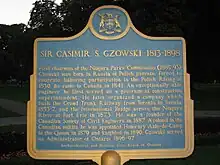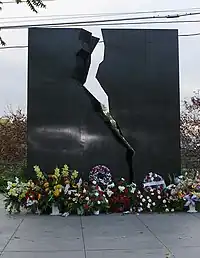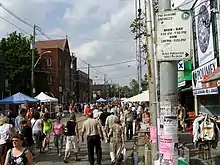Polish Canadians
Polish Canadians (Polish: Polonia w Kanadzie, French: Canadiens Polonais) are citizens of Canada with Polish ancestry, and Poles who immigrated to Canada from abroad. At the 2016 Census, there were 1,106,585 Canadians who claimed full or partial Polish heritage.[1]
 Polish Canadians as % of population by area; also showing Polish Americans | |
| Total population | |
|---|---|
| 983,000 (by ancestry, 2016 Census)[1] | |
| Regions with significant populations | |
| Western Canada, Ontario | |
| Languages | |
| Polish · Canadian English · Canadian French | |
| Religion | |
| Predominantly Roman Catholicism · Judaism[2] | |
| Related ethnic groups | |
| Polish Jews · Polish Americans |
History


The first Polish immigrant on record, was Dominik Barcz, came to Canada in 1752. He was a fur merchant from Gdańsk who settled in Montreal. He was followed in 1757 by Charles Blaskowicz, a deputy surveyor-general of lands. In 1776 arrived army surgeon, August Franz Globensky. His grandson, Charles Auguste Maximilien Globensky, was elected to the House of Commons in Ottawa in 1875.
Among the earliest Polish immigrants to Canada were members of the Watt and De Meuron military regiments from Saxony and Switzerland sent overseas to help the British Army in North America. Several were émigrés who took part in the November Uprising of 1830 and the 1863 insurrection against the Russian Empire in the Russian sector of partitioned Poland.[3]
In 1841, Casimir Stanislaus Gzowski arrived in Canada from partitioned Poland via the US, and for 50 years worked in the engineering, military and community sectors in Toronto and Southern Ontario, for which he was knighted by Queen Victoria. His great-grandson, Peter Gzowski, became one of Canada's famous radio personalities.
Charles Horecki immigrated in 1872. He was an engineer with the cross-Canada railway construction from Edmonton to the Pacific Ocean through the Peace River Valley. Today, a mountain and a body of water in British Columbia are named after him.
Polish immigration stopped during World War I and between the wars, over 100,000 Polish immigrants arrived in Canada.[4]
| Year | Pop. | ±% |
|---|---|---|
| 1901 | 6,285 | — |
| 1911 | 33,652 | +435.4% |
| 1921 | 53,403 | +58.7% |
| 1931 | 145,503 | +172.5% |
| 1941 | 167,485 | +15.1% |
| 1951 | 219,845 | +31.3% |
| 1961 | 323,517 | +47.2% |
| 1971 | 316,430 | −2.2% |
| 1981 | 254,485 | −19.6% |
| 1986 | 612,105 | +140.5% |
| 1991 | 740,710 | +21.0% |
| 1996 | 786,735 | +6.2% |
| 2001 | 817,085 | +3.9% |
| 2006 | 984,565 | +20.5% |
| 2011 | 1,010,705 | +2.7% |
| 2016 | 1,106,585 | +9.5% |
| Source: Statistics Canada [5]: 17 [6][7][8][9][10][11][12][13][14][15][16] Note: 1981 Canadian census did not include multiple ethnic origin responses, thus population is an undercount. | ||
Group-settlers
The first significant group of Polish group-settlers were ethnic Kashubians from northern Poland, who were escaping Prussian and German oppression resulting from the occupation after the partitions. They arrived in Renfrew County of Ontario in 1858, where they founded the settlements of Wilno, Barry's Bay, and Round Lake.[17] By 1890 there were about 270 Kashubian families working in the Madawaska Valley of Renfrew County, mostly in the lumber industry of the Ottawa Valley
The consecutive waves of Polish immigrants in periods from 1890–1914, 1920–1939, and 1941 to this day, settled across Canada from Cape Breton to Vancouver, and made numerous and significant contributions to the agricultural, manufacturing, engineering, teaching, publishing, religious, mining, cultural, professional, sports, military, research, business, governmental and political life in Canada.
Geographical distribution
Data from this section from Statistics Canada, 2021.[18]
Provinces & territories
| Province / Territory | Percent Polish | Total Polish |
|---|---|---|
| 4.1% | 169,925 | |
| 2.7% | 134,635 | |
| 6.0% | 78,860 | |
| 0.5% | 3,815 | |
| 0.3% | 1,290 | |
| 1.5% | 615 | |
| 1.2% | 11,295 | |
| 0.4% | 135 | |
| 3.3% | 461,090 | |
| 0.7% | 1,055 | |
| 0.8% | 63,505 | |
| 5.0% | 55,605 | |
| 2.5% | 985 | |
| 2.7% | 982,820 |
Religious services
All Polish Canadians including their descendants are encouraged by organizations such as the Congress, to preserve their background and retain some ties with Poland and its people. In the past, the most significant role in the preservation of various aspects of Polish traditions and customs among the Polish communities in Canada fell for the Polish urban parishes, which retain the use of the Polish language during services.[19]
The first Polish Catholic priest visited Polish immigrants in 1862 in Kitchener. The first church serving Polish immigrants was built in 1875 in Wilno, Ontario. In Winnipeg, the Holy Ghost Church was built in 1899 with the church in Winnipeg publishing the first Polish newspaper in Canada, Gazeta Katolicka in 1908.[20] In Sydney, Nova Scotia, St. Mary's Polish Parish was established in 1913 by immigrant steelworkers and coal miners, many of whom had previously formed the St. Michael's Polish Benefit Society (est. 1909). The parish remains the only Polish parish in Atlantic Canada, although there is a Polish mission (St. Faustina) in Halifax.
The first Polish-Canadian Roman Catholic bishop is Reverend Mathew Ustrzycki, consecrated in June 1985, auxiliary bishop of the Hamilton Diocese. There are Polish-Canadian priests in many congregations and orders, such as the Franciscans, Jesuits, Redemptorists, Saletinians, Resurrectionists, Oblates, Michaelites, and the Society of Christ. In addition, 80 priests serve in 120 parishes.

Largest Polish Canadian communities


Polish Canadian organizations
- Polonia Inclusive[21][22][23][24]
- Canadian Polish Congress
- Polish Culture Society of Edmonton
- Polish National Union of Canada[25][26]
- Konekt[27]
- Polycultural Immigrant and Community Services[28]
- Canadian Polish Research Institute[29]
- Poland in the Rockies[30][31][32][33][34]
- The Polish Institute of Arts and Sciences in Canada[35][36]
- Canadian Federation of Polish Women[37][38]
- Federation of Polish Jews of Canada[39][40]
Recognition
The Victoria Cross
Numerous Polish-Canadians have been recognized with awards and appointments by the Queen and the Canadian governments as well as universities and various organizations. One of the most notable recipients was Andrew Mynarski, pilot-gunner from Winnipeg, awarded the Victoria Cross posthumously for extreme valor in World War II.
The Order of Canada
- Dr.Tom Brzustowski Waterloo, president of NSERC
- Walter Gretzky, Brantford, Ontario, Canada
- The Honourable Allan H. Wachowich, C.M., A.O.E., Q.C.Edmonton, Alberta. Member November 18, 2019.
Judges
- Their Honours [43]
- Judge Paul Staniszewski – of Toronto, Montreal and the County Court of Windsor
- Judge Alfred Harold Joseph Swencisky – of the Superior Court of BC in Vancouver; past president of the Vancouver Hospital Association[44]
- Judge P. Swiecicki – of the Superior Court of BC in Vancouver
- Judge Allan H. J. Wachowich – of the Court of Queen's Bench in Edmonton
- Chief Judge Edward R. Wachowich - of the Provincial Court of Alberta (deceased 2012)
- Judge E.F. Wrzeszczinski-Wren – of the County Court of Toronto (deceased)[43]
Notable Polish Canadians
See also
References
- "Immigration and Ethnocultural Diversity Highlight Tables". statcan.gc.ca. 25 October 2017.
- Sheldon Kirshner (Sep 15, 2004). "Database" (PDF file, direct download 351 KB). The Polish-Jewish Heritage Foundation of Canada. The Canadian Jewish News, Toronto. Retrieved March 9, 2013.
- Minister of Public Works and Government Services Canada, 2002, Archival Sources for the Study of Polish Canadians. Accessed 2008-01-03
- Reczynska, Anna (1996). For bread and a better future : emigration from Poland to Canada, 1918-1939. Toronto: Multicultural History Society of Ontario. p. 8. ISBN 0-919045-70-7.
- Government of Canada, Statistics Canada (1999-07-29). "Historical statistics of Canada, section A: Population and migration - ARCHIVED". www12.statcan.gc.ca. Retrieved 2022-09-23.
- Government of Canada, Statistics Canada (2013-04-03). "1961 Census of Canada : population : vol. I - part 2 = 1961 Recensement du Canada : population : vol. I - partie 2. Ethnic groups". www12.statcan.gc.ca. Retrieved 2022-09-23.
- Government of Canada, Statistics Canada (2013-04-03). "1971 Census of Canada : population : vol. I - part 3 = Recensement du Canada 1971 : population : vol. I - partie 3. Ethnic groups". www12.statcan.gc.ca. Retrieved 2022-09-23.
- Government of Canada, Statistics Canada (2013-04-03). "1981 Census of Canada : volume 1 - national series : population = Recensement du Canada de 1981 : volume 1 - série nationale : population. Ethnic origin". www12.statcan.gc.ca. Retrieved 2022-09-23.
- Government of Canada, Statistics Canada (2013-04-03). "Census Canada 1986 Profile of ethnic groups". www12.statcan.gc.ca. Retrieved 2022-09-23.
- Government of Canada, Statistics Canada (2013-04-03). "1986 Census of Canada: Ethnic Diversity In Canada". www12.statcan.gc.ca. Retrieved 2022-09-23.
- Government of Canada, Statistics Canada (2013-04-03). "1991 Census: The nation. Ethnic origin". www12.statcan.gc.ca. Retrieved 2022-09-23.
- Government of Canada, Statistics Canada (2019-06-04). "Data tables, 1996 Census Population by Ethnic Origin (188) and Sex (3), Showing Single and Multiple Responses (3), for Canada, Provinces, Territories and Census Metropolitan Areas, 1996 Census (20% Sample Data)". www12.statcan.gc.ca. Retrieved 2022-09-23.
- Government of Canada, Statistics Canada (2013-12-23). "Ethnic Origin (232), Sex (3) and Single and Multiple Responses (3) for Population, for Canada, Provinces, Territories, Census Metropolitan Areas and Census Agglomerations, 2001 Census - 20% Sample Data". www12.statcan.gc.ca. Retrieved 2022-09-23.
- Government of Canada, Statistics Canada (2020-05-01). "Ethnic Origin (247), Single and Multiple Ethnic Origin Responses (3) and Sex (3) for the Population of Canada, Provinces, Territories, Census Metropolitan Areas and Census Agglomerations, 2006 Census - 20% Sample Data". www12.statcan.gc.ca. Retrieved 2022-09-23.
- Government of Canada, Statistics Canada (2019-01-23). "Ethnic Origin (264), Single and Multiple Ethnic Origin Responses (3), Generation Status (4), Age Groups (10) and Sex (3) for the Population in Private Households of Canada, Provinces, Territories, Census Metropolitan Areas and Census Agglomerations, 2011 National Household Survey". www12.statcan.gc.ca. Retrieved 2022-09-23.
- Government of Canada, Statistics Canada (2019-06-17). "Ethnic Origin (279), Single and Multiple Ethnic Origin Responses (3), Generation Status (4), Age (12) and Sex (3) for the Population in Private Households of Canada, Provinces and Territories, Census Metropolitan Areas and Census Agglomerations, 2016 Census - 25% Sample Data". www12.statcan.gc.ca. Retrieved 2022-09-23.
- Blank, Joshua C. (2016). Creating Kashubia: History, Memory and Identity in Canada's First Polish Community. Montreal & Kingston: McGill-Queen's University Press. ISBN 9780773547209.
- "Census Profile, 2021 Census of Population". 9 February 2022.
- Henry Radecki, Ethnic organizational dynamics: the Polish group in Canada. Page 102 Wilfrid Laurier Univ. Press, 1979 – 275 pages
- Heydenkorn, Benedykt (Spring–Summer 1982). "Polish press in Canada". Polyphony: The Bulletin of the Multicultural History Society of Ontario. 4 (1): 35. Retrieved 2 August 2013.
- "Polonia Inclusive - Community supporting culture, diversity and advocacy in Canada, Poland and around the world". Polonia Inclusive. Retrieved 2023-07-25.
- "Polonia Inclusive". www.facebook.com. Retrieved 2023-07-25.
- "Polonia Inclusive (@poloniainclusive) • Instagram photos and videos". www.instagram.com. Retrieved 2023-07-25.
- "Polonia Inclusive Mailing List". Mail Chip. Retrieved 2023-07-25.
- "polish national union". polishnationalunion.ca. Retrieved 29 April 2022.
- "Polish Organizations and Cultural Centers in Canada". Gov.PL. Retrieved 29 April 2022.
- "Polish Canadian Professionals". Konekt. Retrieved 29 April 2022.
- "Who We Are - History". Polycultural Immigrant and Community Services. Retrieved 29 April 2022.
- "Collecting and preserving the history, culture, and development of the Polish group in Canada". The Canadian Polish Research Institute. Retrieved 29 April 2022.
- "Poland in the Rockies: Looking back". Cosmopolitan Review. Retrieved 29 April 2022.
- "Resources :: Polish Community". Łowiczanie Polish Folk Ensemble. Retrieved 29 April 2022.
- "Poland in the Rockies". Polish Winnipeg. Retrieved 29 April 2022.
- "Websites for Polish Americans". Polish American Librarians Association. Retrieved 29 April 2022.
- "about". Young Polish-Canadian Professionals Association. Retrieved 29 April 2022.
- "ABOUT". polish institute. Retrieved 29 April 2022.
- "Polish Organizations (155)". Polish Canadians Network. Retrieved 29 April 2022.
- "Polish Canadian Women's Federation - Federacja Polek w Kanadzie". FederacjaPolek.ca. Retrieved 29 April 2022.
- "Polish Organizations in Canada". Polish Alliance of Canada. Retrieved 29 April 2022.
- "Federation of Polish Jews of Canada". Ontario Jewish Archives. Retrieved 29 April 2022.
- "Federation of Polish Jews of Canada". Canadian Jewish Heritage Network. Retrieved 29 April 2022.
- Services, Government of Canada, Office of the Secretary to the Governor General, Information and Media. "Order of Canada". Archive.gg.ca. Retrieved 27 May 2018.
{{cite web}}: CS1 maint: multiple names: authors list (link) - Gonzalez, Ramon (January 11, 2007). "Brilliant psychiatrist and Polish patriot dies". Western Catholic Reporter. Edmonton. Archived from the original on 2007-08-10. Retrieved 29 April 2022.
- CPC. "In the legal profession". Contribution of Poles to the Canadian Society. Canadian Polish Congress. Retrieved June 15, 2013.
- "FamilySearch". Familysearch.org. Retrieved 27 May 2018.
External links
- Polonia Edmonton
- History of Ours: the Polish Community in Brantford - Brantford library
- Polish: Polonijne parafie rzymskokatolickie w Kanadzie
- Zwiazkowiec (Alliancer), 1935–1978 digitized issues of Toronto newspaper - Multicultural Canada